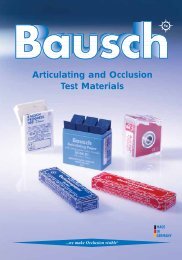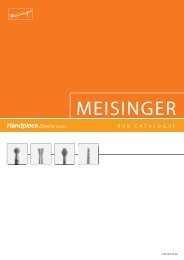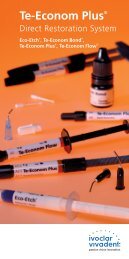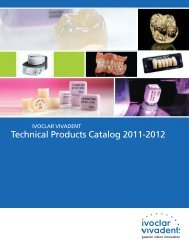BISCO DENTAL PRODUCTS CANADA - dentes.sk
BISCO DENTAL PRODUCTS CANADA - dentes.sk
BISCO DENTAL PRODUCTS CANADA - dentes.sk
Create successful ePaper yourself
Turn your PDF publications into a flip-book with our unique Google optimized e-Paper software.
DESENSITIZER<br />
DESENSITIZER<br />
BISBLOCK<br />
Oxalate Dentin Desensitizer<br />
<strong>BISCO</strong>’s patented* oxalate dentin desensitizer and its unique application<br />
technique are designed to prevent intra-tubular fluid movement which causes<br />
dentin sensitivity (hydrodynamic theory---Brännström, 1966).<br />
When BisBlock is applied on dentin, after surface decalcification (by acid etching and rinsing), calcium<br />
oxalate crystals are formed only within the tubules (SEMs shown). This results in the blockage of<br />
dentinal fluid movement and eliminates sensitivity, while leaving the dentin surface unobstructed to<br />
readily accept adhesive for ideally bonded restorations.<br />
* U.S. Patents: 6,406,529 and 6,506,055 by Pashley et al.<br />
BENEFITS<br />
Deep penetration into the dentinal tubules to effectively BLOCK dentinal fluid movement<br />
Resists dislodging caused by toothbrush abrasion. Excellent bond strength still achieved.<br />
Yellow colour of solution aids placement to ensure complete coverage<br />
Safe for patient’s tissue and pulp<br />
Ordering Information<br />
• BisBlock KIT: (6ml BisBlock, 6ml One-Step Plus,<br />
5g Syr Uni-Etch & Accessories)<br />
• REFILL BOTTLE (6ml)<br />
FREE SAMPLE<br />
SEM VIEW<br />
Ca Oxalate Crystals<br />
BISBLOCK FAQ’s<br />
Q: Why can’t BisBlock be used with Self-<br />
Etching primers<br />
A: Acidic self-etching products and acidic<br />
adhesives will partially dissolve the calcium<br />
oxalate crystals and reduce bond strengths.<br />
Top View<br />
Cross Section View<br />
Left, SEM top view, using a patented technique, BisBlock reacts with calcium ions in 30 seconds to form<br />
calcium oxalate crystals in the dentinal tubules, but not on the surface. Right, SEM cross section view,<br />
oxalate crystals within tubules halt dentinal fluid movement and cannot be mechanically dislodged, thus<br />
preventing sensitivity. SEM courtesy of David Pashley, D.M.D., Ph.D.<br />
Results of Past Attempts<br />
• Crystals formed to cover the surface of the dentin<br />
tubules which blocked fluid movement, but were easily<br />
dislodged by brushing, flossing, etc., This resulted in<br />
returned sensitivity a short time later.<br />
• Bond strengths were drastically reduced due to crystal<br />
formations blocking adhesive penetration into the tubules.<br />
Q: What happens if I use a Self-Etching<br />
Primer/Adhesive or a highly acidic adhesive<br />
A: Bond strengths will be drastically reduced.<br />
Q: What is the shelf life of BisBlock<br />
A:2 Years.<br />
Q: How many applications in one bottle<br />
A: Bottle yields approximately 145 drops.<br />
Depending on the procedure, the number of<br />
applications will vary.<br />
Q: I am not planning on anesthetizing my<br />
patient prior to using BisBlock. How may I<br />
maximize patient comfort<br />
A: The etch, water, BisBlock and the adhesive<br />
may be warmed to body temperature<br />
1-800-667-8811 / www.biscocanada.com 11












